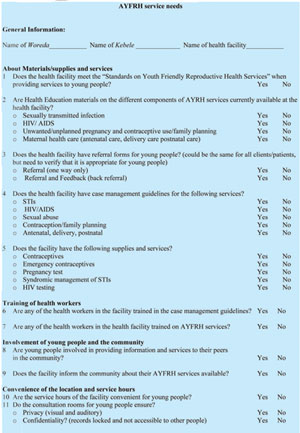Use 'Print preview' to check the number of pages and printer settings.
Print functionality varies between browsers.
Printable page generated Friday, 21 November 2025, 5:50 AM
Adolescent and Youth Reproductive Health: 13. Adolescent and Reproductive Health Programme Management
Study Session 13 Adolescent and Youth Reproductive Health Programme Management
Introduction
In Study Session 1 you learned that young people aged 10–24 years old make up about one third of the Ethiopian population and are faced with many reproductive health problems such as unwanted pregnancy, abortions, sexually transmitted infections (STIs) including HIV which progresses to AIDS. In the preceding sessions you have learned what should be done to help young people have good sexual and reproductive health. You have also learned that the Government of Ethiopia is committed to addressing the reproductive health problems of young people in Ethiopia. It is a reflection of the government’s commitment to AYRH that this Module is included in your study. The reproductive health (RH) problems of young people are mainly addressed through AYRH programmes that are implemented at community level. In this session you will learn how to plan, implement and monitor AYRH services and programmes in your community.
Learning Outcomes for Study Session 13
When you have studied this session, you should be able to:
13.1 Define and use correctly all of the key words printed in bold. (SAQs 13.1, 13.2and 13.3)
13.2 Calculate the size of the target group for and coverage of AYRH services. (SAQ 13.1)
13.3 Describe the steps in organising AYRH services. (SAQs 13.1 and 13.2)
13.4 Explain how to organise AYRH programmes at schools and in the community. (SAQ 13.2 and 13.3)
13.5 Know how to monitor and evaluate an AYRH programme. (SAQ 13.3)
13.1 Planning an AYRH programme for your community
13.1.1 Calculating the size of your target group
AYRH services could be delivered through various outlets such as the health post, household, community, schools, and other social institutions such as religious institutions, as well as areas frequented by young people. Before you provide services it is important that you know the size of your target group and what specific services they need and through which outlets you could provide the services.
How would you find out the size of your target group?
You learned how to conduct a survey of your community in the Health Education, Advocacy and Community Mobilisation Module. This is one of the first things that you do when you enter a community before starting to provide any service. From that survey, you know the number of persons by age and sex for each household and for the whole community or kebele. From the survey you can find out the number of young people aged 10–24 years old (Figure 13.1).
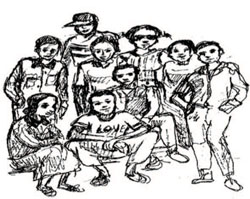
It is helpful to make a table (see Table 13.1) categorising the young people by age and sex group. This will help you to plan and tailor your AYRH programmes.
For example, suppose you found that the total population of your kebele was 5,000 and the total number of young people in the age group 10-24 years was 1,500 you should assume that half of these are females and each age group is one third of the total. This is shown in Box 13.1.
What is the percentage of young people in your community?
The percentage of young people in your kebele = (1,500 ÷ 5,000) x 100 = 30%
| Age | Sex | Total | |
|---|---|---|---|
| Female | Male | ||
| 10–14 | 250 | 250 | 500 |
| 15–19 | 250 | 250 | 500 |
| 20–24 | 250 | 250 | 500 |
| Total | 750 | 750 | 1,500 |
Calculating the number of young people in the kebele by age and sex is important for:
- planning tailor-made RH information and services
- calculating the utilisation of services by age and sex
- monitoring progress and evaluating achievements.
13.1.2 Calculating AYRH service coverage
It is important to understand the common indicators for calculating service coverage; these are shown in Box 13.1.
Box 13.1 AYRH indicators
- Proportion of young people using condoms (for age groups 15–19 and 20–24 years)
- Contraceptive prevalence rate among sexually active young people for age groups 15–19 and 20–24 years (contraceptive prevalence = proportion of adolescents using contraceptives)
- Prevalence of STIs among female and male young people in age groups 15–19 and 20–24 years (prevalence of STIs = proportion of young people with STIs)
- Proportion of pregnant women aged 15–19 and 20–24 years old seeking antenatal care (ANC)
- Proportion of young women aged 15–19 and 20–24 years old delivered at the health post
- Proportion of young women who delivered with the assistance of a trained health service provider
- Proportion of young people referred for HIV counselling and testing
- Proportion of young women referred for abortion-related services
- Proportion of young women counselled on sexual abuse.
If we want to calculate ANC coverage among young pregnant women aged 15–19 years we divide the total number of young pregnant women aged 15–19 years who use ANC by the total number of young pregnant women aged 15–19 years in the kebele and multiply by 100.
ANC coverage among young women 15–19 =

The same can be done for the other indicators.
How would you calculate ANC coverage among women aged 20–24 years?
ANC coverage among young women 20–24 =

13.1.3 Organising adolescent and youth friendly RH services
Stop reading for a moment and think of your past experience. How did you organise and start providing adolescent- and youth-friendly reproductive health (AYFRH) services at your health post?
In order to organise AYFRH services it is important to start with a needs assessment of the adolescent and youth reproductive services at the health post. In Box 13.2 you see the five steps that you can follow to organise AYFRH services at your level.
Box 13.3 Steps in organising AYFRH services
- Conduct a needs assessment of adolescent and youth services provided at the health facility
- Assess whether the health workers are trained to provide AYFRH services and find out what materials are available in the health facility
- Identify existing problems in providing RH service for young people
- Develop proposals to solve the problems identified
- Present an action plan to implement the proposals.
We will now show you how you go about each of the above five steps.
Step 1: Conducting a needs assessment of existing services at the health post
Figure 13.2 is a needs assessment tool. You use it to collect the required information on the services already provided. It will help you identify existing problems and the people and materials available to provide RH services for young people. In addition, the needs assessment tool will help you collect information on how the health post keeps track of data on AYRH services provided. Overall, the tool will help you determine whether the facility has youth-friendly characteristics.
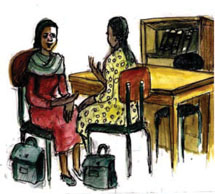
What are the characteristics of AYFRH services? (If you do not remember, reread Section 10.1.1. in this Module.)
The major characteristics of AYFRH services include:
- Convenient hours
- Convenient location
- Adequate space and sufficient privacy
- Availability of peer education and a counselling programme
- Affordable fees for the service
- Involves young people in the provision of information and services (Figure 13.3)
- Informs the community about services for AYRH
- Availability of health workers trained in AYFRH services
- Materials available for AYFRH service provision
As you see in Figure 13.2 there are about 11 questions related to AYFRH service categorised under the following main headings:
- Materials/supplies and services
- Training of health workers
- Involvement of the young people and the community
- Convenience of the location and service hours
Now look at Figure 13.2.
Step 2: Assess whether the health workers are trained to provide AYFRH services and find out what materials are available in the health facility
How will you carry out step 2?
The information that you want has been gathered using the needs assessment tool (Figure 13.2).
Step 3: Identifying problems related to AYFRH
Activity 13.1
Figure 13.2 is called an assessment tool because it is used like any other tool to enable you to carry out a task (e.g. a spoon is a tool that can be used to stir food in a cooking pot). Use this assessment tool (i.e. Figure 31.2) to collect information about the services that are available at your health post. If you have worked for sometime in the health post, you will be familiar with the facilities and you can be the source of information for the assessment. If you are a newcomer to the facility and there are other health workers or practitioners you should talk to them and collect the information jointly.
Based on the information you collect, use Table 13.2 to categorise the problems you found. Copy the table into your study diary and show this to your Tutor.
| Materials and services | Training of health workers | Involvement of the young people and the community | Convenience of the location and service hours |
|---|---|---|---|
Steps 4: Developing a proposal
Now you should develop a proposal to show how you are going to solve the problems you identified in your assessment. You may not be able to respond to all of the problems you have identified. Therefore you should prioritise the problems based on the importance of the problem and the resources you have or you could acquire. If you can’t address the problems at your level, the proposal would help you request support from the health centre or woreda health office. The proposal should have the problems identified (it is good if you have prioritised the problems and put only two or three priority problems in your proposal). You need to include in your proposal what you want to achieve by addressing the identified problem-we usually call this the objective. You may have different ways of achieving your objectives — we call these ways strategies — and it is good also to indicate your strategies in your proposal.
You may need to do one or more activities for each of your prioritised problems. You should put the major activity for each problem in your proposal. Addressing some of your identified problems may require resources; if you think you need resources for your priority problems, indicate in your proposal what resources you need. Finally, you should include the time within which you would like to accomplish your proposed activities. Table 3.3 is a form that is suitable for developing a proposal. It has been completed to show you how you can use it. For example, let us say that when you conducted your needs assessment you saw that the health post had no health education materials on contraceptives. You decided to prioritise this as a major problem and used a form (see Table 13.3) to develop your proposal.
Problem: Materials and services No health education materials on contraception available at the health post | |
|---|---|
| Objective | Make health education materials on contraceptives available at the health post |
| Strategy | Mobilise support from the woreda health office, health centre and NGOs working in the kebele |
| Activity | Collect available health education materials |
| Resource | Transport and perdiem cost to travel to the woreda health office and health centre |
| Time | One month |
Step 5: Developing an action plan
With the proposal it is useful to develop an action plan for each problem that you have identified. The action plan is a very simple tool which will help you organise yourself to respond to the problems to AYFRH service provision at your health post. In the action plan you put very specific actions. The activities you have put in the proposal may be more general activities. Table 13.4 shows a form that you can use to help you develop an action plan. You need to indicate in your action plan by whom and when the specific action will be carried out. Just as for the proposal Table 13.4 has been completed for the problem identified in the needs assessment.
| Problem | Action Required | Person responsible | Date to be carried out |
|---|---|---|---|
| Lack of health education materials on contraceptives at the health post | Collecting health education materials Request both orally and through formal letter that (i) the woreda health office Or (ii) the NGO working in the kebele (if any) Or (iii) the health centre provides you with health education materials on contraceptives | Health Extension Practitioner | September 1st 2005 (E.C.) |
13.2 Organising school based AYRH programmes
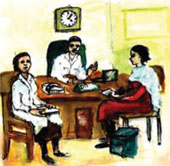
For successful school-based activities, it is important that you work with the teachers and students themselves in each particular school (Figure 13.4). Initial discussion with some of the teachers and the students could give you ideas on the topics you need to focus on and the best strategies to employ. Remember that you need to tailor the information that you provide to students according to their age. You can use the various promotional strategies that you learned in the Health Education, Advocacy and Community Mobilisation Module and in Study Session 12 of this Module to reach young people who are still in school.
Name some suitable strategies for reaching young people in school.
Most schools have clubs organised to respond to selected thematic areas or topics like an environmental health club and anti-AIDS clubs. A suitable strategy would be to visit the anti-AIDS club and work with young people there.
If the schools have already established clubs, it is a good opportunity for you to reach the students in the schools through the existing clubs. The anti-AIDS club is appropriate for dealing with AYRH issues. If the schools do not have clubs, you can help them establish a club that can work on AYRH in the school.
How would you help the school establish a club if it doesn’t have one?
You can do this by a holding an initial discussion with the school officials, biology teachers, and student representatives from each grade. They can mobilise the students to be members of the club. Your role will be to educate the club members and they will work on most of the promotional activities.
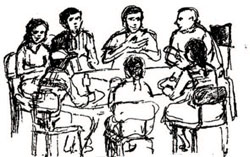
It is good to assess on a regular basis the changes that have been brought about by your school-based interventions. You can do this assessment by asking questions in the same way that you did when you held your initial discussions with the teachers and the students. Asking the club leaders how frequently they meet, how many of the members are girls, how many are boys, what specific promotional activities they have been doing, what challenges they have faced and what type of support they need from you will help you to gain a better understanding of the value of your school-based interventions (Figure 13.5). It is a good idea to assess the activities every three months because this will give you important information to help you to plan your next activities.
13.3 Organising household and community level AYRH Programmes
It is at household and community level that you can reach young people who do not go to school including those who are married. From the survey that you conducted, you already have the number of young people in your community. In addition to categorising them by age (10–14, 15–19, 20–24), it is now advisable to categorise them by marital status in order to tailor your messages to the specific groups. Therefore it is important that you have specific household and community level interventions for this group of young people. At household level, when you plan a household visit for other health activities it is a good idea to integrate reproductive health-related activities and address them in each household where there are young people.
Once you have the different categories of young people by age and sex, you can form peer groups in each sub-kebele (gotts). First you must train the peer educators (see the previous study session in this Module). The groups meet for regular sessions: maybe every two weeks or every month depending on how often they wish to discuss issues of concern to them. You will be the resource person when needed. As each peer group is likely to require your assistance at some point, it is good idea if you develop a plan for peer education related activities.
To be able to plan support activities and assess their effectiveness you need the following information:
- The number of peer education groups in the kebele
- The number of peer members in each group
- The number of sessions each group conducted during the quarter
- The topics they covered in the peer education sessions.
Try to ensure that the peer groups do have similar characteristics, like married girls in one group; unmarried in another group.
If you follow the five steps when setting up AYFRH services at your health post you will be able to improve the sexual and reproductive health of the young people in your community with the help of all you have learned in this Module.
Summary of Study Session 13
In this session you have learned that:
- AYRH services could be delivered through various outlets and these include: health post, household, community and schools.
- You should know the size of the target group for AYRH programme in your kebele. You can get this number from the household survey that you initially conducted. Categorising the target group by age and sex (10-14, 15-19, 20-24) is important for:
- planning tailor-made RH information and services
- calculating the utilisation of services by age and sex
- monitoring progress and evaluating achievements.
- AYRH service coverage is calculated by dividing the total number of young people utilising the particular service by the total number of young people in the kebele.
- The steps in organising AYFRH services at your health post include:
- Conducting a needs assessment of AYRH services provided at the health facility
- Identifying human resources and materials available at the health post
- Identifying existing problems in providing RH services for young people
- Developing proposals to solve the identified problems
- Presenting an action plan to implement the proposals.
- School based AYRH programmes should be tailored to the age of the group and could be implemented through clubs.
- Community based AYRH programmes should also be tailored to the age and marital status of the young people and could be implemented through clubs and involve different activities including peer education sessions and community conversations.
- Collecting, analysing and reporting data on the indicators of AYRH service coverage should be used for monitoring and evaluating AYRH services.
Self -Assessment Questions (SAQs) for Study Session 13
Now that you have completed this study session, you can assess how well you have achieved its Learning Outcomes by answering the questions below. Write your answers in your Study Diary and discuss them with your Distance Learning Tutor at the next Study Support Meeting. You can check your answers with the Notes on the Self-Assessment Questions at the end of this Module.
SAQ 13.1 (tests Learning Outcomes 13.1 and 13.2)
In 2003 E.C. the total number of young people aged 10-24 years in a kebele whose total population is 6,000 was about one third of the total population. Females constitute half of the young people of age 10-24 years. From the same year, you have data showing that the total number of young people aged 10-24 years in the kebele who were treated for STIs was 200 out of which 50 were female.
- a.What is the prevalence of STIs among young people aged 10-24 years in this kebele?
- b.What is the prevalence of STIs among young females aged 10-24 years in this kebele?
- c.What is the prevalence of STIs among young males aged 10-24 years in this kebele?
Answer
a.Prevalence of STIs among young people aged 10–24 years =

the prevalence of STIs among young people aged 10–24 years is 10%
b.Prevalence of STI among young females aged 10–24 years =

the prevalence of STIs among young females aged 10–24 years is 5%
c.Prevalence of STI among young people of age 10–24 =

the prevalence of STIs among young males aged 10–24 years is 15%
SAQ 13.2 (tests Learning Outcomes13.1 and 13.3)
You are assigned to work in a kebele called Selamdar. One of your assignments is to provide adolescent and youth friendly reproductive health (AYFRH) services in the kebele. Discuss the steps that you will follow to organise AYFRH service in this kebele.
Answer
The steps in organising AYFRH services include:
- Conducting a needs assessment of adolescent and youth services provided at the health post in Selamdar.
- Identify human resources and materials available in the health post.
- Identify existing problems in providing RH service for young people.
- Develop proposals to solve the problems identified.
- Present an action plan to implement the proposals.
SAQ 13.3 (tests Learning Outcomes 13.1, 13.4 and 13.5)
Discuss what approaches you will use to organise AYRH services at community and school level.
Answer
When organising AYRH programmes at community and school level you should consider the following:
- Tailoring messages for different groups (segmentation by age, sex, marital status)
- Involving young people
- Involving community members and teachers
- Establishing clubs
- Conducting peer education sessions
- Building the capacity of the clubs through training
- Regular monitoring.
